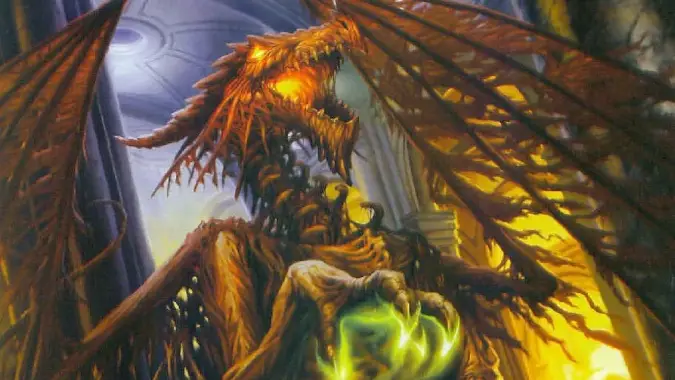How to add content from Fizban’s Treasury of Dragons to your own D&D campaign

We previously discussed Fizban’s Treasury of Dragons and how it changes up the typical lore for Dragons in Dungeons and Dragons, but today I want to talk to you about how to use the book in your game, whether you’re running a series of pre-made adventures, a complete homebrew setting, or something in between. The book itself is designed for ease of use, so it’s really not difficult to break out elements from it and use them in your campaign however you see fit.
For starters, always keep in mind that you don’t have to use anything in this book, and if you choose to do so (as I’m going to, because there’s gold in this book, make no mistake) you’re always free to decide exactly how much of it to use. Let’s say you don’t particularly care for the First World idea introduced here — you’ve got your own campaign cosmology already. That’s fine. You can still absolutely use the various kinds of Dragons, the playable Dragonborn options, even the various Dragon Magic and magic items without it. As is the case in all of these kinds of supplemental books, what you have here is a toolkit — just as you’re not obliged to use all the tools in your set if they’re not useful for the task at hand, the same applies to Fizban’s.
So let’s take a look at how to bring some of these Draconic options into your game.

Take what will suit your own game
For example, in my Riatan campaign (the one that’s likely ending next month) I’ve done a fair amount with Verth, the Dragon of Destruction, a divine being that is essentially a cosmic force of balance, the destroyer as means to enable creation. Bahamut and Tiamat don’t even exist in my setting. But I could easily just use the stats for the Aspect of Tiamat to represent Verth’s avatar, the Mnarth nor Verth (Talon of the Destroyer) and it’s not like the party will likely notice or care. The important thing is that it’s a big freaking Dragon.
There’s a broad and expansive bestiary in the book, in fact, with creatures like the Elder Brain Dragon, the Eyedrake, and non-draconic foes like Hoard Mimics. You can and should feel absolutely free to take and use any of these creatures and either use them exactly as written, or change them up — you could describe the Eye Drake as less a creation of a Beholder’s obsessive fever dreams about a Dragon it hates, and more a deliberate experiment to create a unique Beholder. You don’t even have to describe it as a Drake at all — you can use the stat block exactly as written and simply describe it as a strange but still overtly Beholder variant. The Elder Brain Dragon? You could absolutely use that as a flying Elder Brain without any draconic elements at all, and describe its breath weapon as a Ceremorphosis Swarm that orbits it.

You don’t have to use everything to use anything
That said, don’t be afraid to actually steal and use any element from this book you want to as is — that’s why Wizards of the Coast mades supplemental sourcebooks like this in the first place. Say you’re running a Candlekeep Mysteries campaign, and the party is getting bored and restless and is clearly champing at the bit for a fight. Throw in a CR 7 Liondrake as written and you’ve got a good fight for a party of level 5 characters, easy as that. Chapters such as Chapter 1 — Character Creation and Chapter 2 – Dragon Magic are full of elements you can transplant wholesale into your campaign almost entirely as written, especially if you’re running a game in one of the settings like Eberron, Faerun, or Theros. Indeed, the arrival of powerful Dragons into a Theros campaign would be an epic challenge for a party of characters to overcome.
Finally, even if you don’t end up using the lore aspects, the chapter about Dragons in Play is an excellent guide to how to make your Dragons more unique, with their own specific personalities and goals. Just because Trakhanalorinax is an Ancient Red Dragon doesn’t mean she can’t be personable and even charming — she’s a being of terrifying power, yes, but she’s also had a long life full of experiences and is brilliant enough to know how to be disarming if she wishes to be.
Overall, this is absolutely an excellent book that has so so much to offer for any campaign, from a host of unique monsters to fight, to new magic spells and items, and even new character options like the Gem Dragonborn or the Hoard Item rules for powerful magic items inside a Dragon’s Hoard, there’s a plethora of excellent stuff to use in your game. So grab whatever elements you want, leave what you don’t, and enjoy having more Dragons in your D&D game.
Please consider supporting our Patreon!
Join the Discussion
Blizzard Watch is a safe space for all readers. By leaving comments on this site you agree to follow our commenting and community guidelines.
 @MatthewWRossi
@MatthewWRossi




